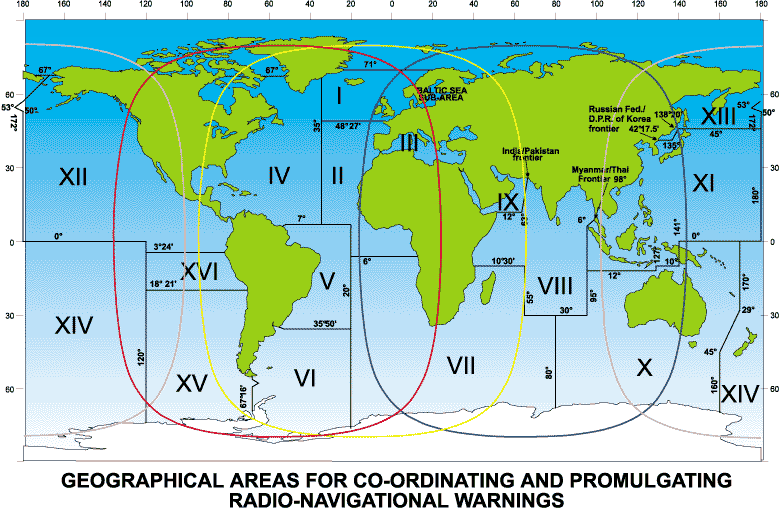
The GMDSS enables a ship in distress to send an alert using various radio systems. These systems are designed such that the alert has a very high probability of being received by either shore rescue authorities and/or other vessels in the area.
Equipment performing GMDSS functions must be simple to operate and (wherever appropriate) be designed for unattended operation.
Distress Alerts must be able to be initiated from the position from which the ship is normally navigated (i.e.; the bridge).
EPIRBs are required to be installed close to, or capable of remote activation from the position from which the ship is normally navigated.
The SOLAS GMDSS regulations are structured such that all GMDSS ships are required to carry a minimum set of equipment, with (basically) more equipment being required the further the ship travels from land.
The SOLAS GMDSS regulations do not make particularly easy reading - a simplified version of the equipment required to be carried for each sea area is detailed below.
GMDSS ships are required to carry the following minimum equipment:
Note 1 - Voice watch required on channel 16 until 2005.
Note 2 - in practice, this means that all GMDSS A3 and A4 vessels are required to carry at least one Inmarsat C system.

Every ship engaged on voyages exclusively in sea area A1 shall be provided with the minimum equipment specified previously, with the option to replace the 406 EPIRB with a VHF DSC EPIRB.
Every ship engaged on voyages beyond sea area A1, but remaining within sea area A2, shall be provided with the minimum equipment specified previously, plus:

The ship shall, in addition, be capable of transmitting and receiving general radiocommunications using radiotelephony or direct-printing telegraphy by:

These vessels have two options to satisfy their GMDSS requirements. The options allow a vessel to choose from the primary method to be used for ship-shore alerting ;
Every ship engaged on voyages beyond sea areas A1 and A2, but remaining within sea area A3 shall be provided with the minimum equipment specified previously, plus either:
OR

In addition, ships shall be capable of transmitting and receiving general radiocommunications using radiotelephony or direct-printing telegraphy by an MF/HF radio installation operating on working frequencies in the (marine) bands between 1,605 kHz and 27,500 kHz. This requirement is normally fulfilled by the addition of this capability in the MF/HF equipment referred to earlier.
In practice, MF only transceivers are not produced - all marine MF radio equipment is also fitted with HF facilities.
In addition to carrying the equipment listed previously, every ship engaged on voyages in all sea areas shall be provided with:
In addition, ships shall be capable of transmitting and receiving general radiocommunications using radiotelephony or direct-printing telegraphy by an MF/HF radio installation as described earlier.
Regulation 15 of the SOLAS GMDSS regulations defines 3 methods to ensure availability of GMDSS equipment at sea;
Ships engaged on voyages in sea areas A1 and A2 are required to use at least one of the three maintenance methods outlined above, or a combination as may be approved by their administration. Ships engaged on voyages in sea areas A3 and A4 are required to use at least two of the methods outlined above.
And of course what all that means is that 99% of A3 GMDSS ships, along with probably 100% of A1 and A2 GMDSS ships do not opt for at sea maintenance - they either duplicate the equipment and use shore based maintenance (for A3 ships), or use shore based maintenance only (A1 and A2 ships).
GMDSS ships operating in A3 areas are required to provide the following duplicated equipment;
Many GMDSS ships opt for the latter option (1 Inmarsat C and one MF/HF DSC system), on cost grounds. Unfortunately, this has proven to be one of the underlying causes of the present extremely high false alerting rate on some GMDSS systems.
GMDSS equipment is required to be powered from three sources of supply:
The batteries are required to have a capacity to power the equipment for 1 hour on ships with an emergency generator, and 6 hours on ships not fitted with an emergency generator.
The batteries must be charged by an automatic charger, which is also required to be powered from the main and emergency generators.
Changeover from AC to battery supply must be automatic, and effected in such a way that any any data held by the equipment is not corrupted (i.e.: "no break").
There are a number of different types of GMDSS qualifications, as follows:
The First and Second Radio-Electronic Certificates are diploma and associate diploma level technical qualifications. They are designed for Ship's Radio-Electronic Officers, who sail on GMDSS ships which use the option of at-sea electronic maintenance.
The GMDSS General Operator's Certificate is a non-technical operator qualification, designed for Navigating Officers.
The GMDSS General Operator's Certificate is normally awarded after a ten day course and examination